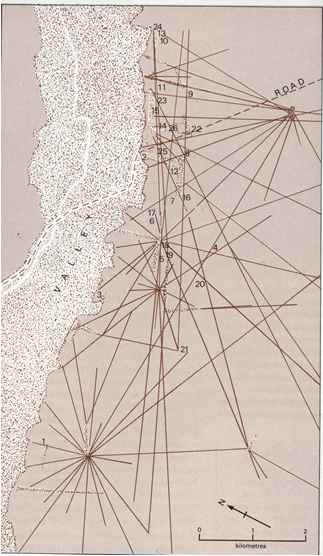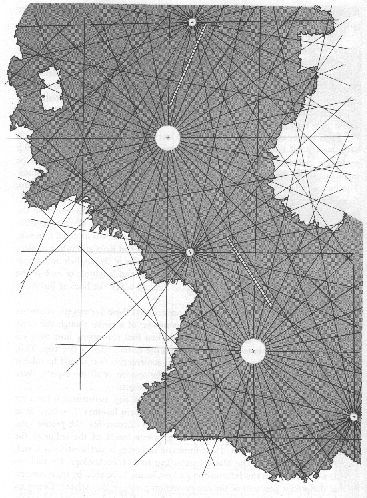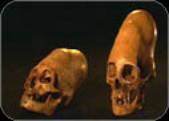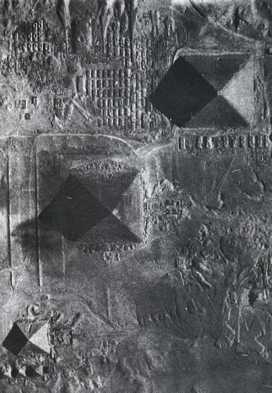Belt of Orion?
The lines appear random unless they are viewed from a great height. Only then does it become obvious that many of the lines originate from common points. In fact, there is only one line that doesn’t. The others radiate out from common points, as if stars were being drawn.
Is it possible that the “radiating centres” are a map of the stars? When Aveni’s plan of the ray centres is held next to a sky chart, the similarity is uncanny. The connection is made stronger if we let the Nazca River Valley represent the Milky Way, just as the ancient Egyptians did with the Nile.
Alongside the Nile, the Giza pyramids have been shown to have the same pattern as the Belt of Orion. Three of the Nazcan “stars” are more prominent than the others, and they almost form a straight line of their own, although the third is slightly astray. Their relationship appears to be the same as the Giza pyramids, imitating the belt of Orion. Could this be true? If it were, then perhaps they are part of a global pattern of coded messages, warning us of another flood will come sometime in the future.
 |

Images sourced from:
|
|
 Or then again, perhaps the Nazca Lines are a terrestrial map. The image on the left shows the portolan design lines extracted from the Piri Reis map. Does it make sense, that if the Piri Reis map is the most accurate ancient map found to date, that another ancient map (which happens to be huge and drawn on the ground) would have similar lines upon it? Or then again, perhaps the Nazca Lines are a terrestrial map. The image on the left shows the portolan design lines extracted from the Piri Reis map. Does it make sense, that if the Piri Reis map is the most accurate ancient map found to date, that another ancient map (which happens to be huge and drawn on the ground) would have similar lines upon it?
Hopefully somebody will have the time and patience to compare the Nazca map with every location on Earth and perhaps find that it fits somewhere… **The Piri Reis map also features some strange animals! Other instances of this pattern could have come from a common ancient knowledge, like: |
Furthering the link with Giza is the city of Cahuachi, just south of the lines. Today it is almost indistinguishable from the desert surrounding it, yet it covers 370 acres and contains plazas, terraces and some 40 structures. There are six pyramids – the largest of which is 30 metres high.[16] [17] [18]
 |
It appears that Cahuachi was a ceremonial centre, with few people actually living there. Puzzling mortuary practices occurred at Cahuachi. Ninety percent of the skulls found have the distinctive cabeza larga (long head) type of deformation.19] |
This was achieved by wrapping the heads of newborn babies with leather or wood, causing their skulls to grow into extraordinary shapes. Many of the dismembered skulls have also had round holes cut into their foreheads, a practice known as trepanning.20]
Further clues of an advanced society can be found nearby. The Nazca Indians may have been living in a barren area, but they managed to cope quite well. They created a system of underground channels to bring them water from kilometres away, and some of their hydraulic schemes are still in working order.
As time passes by, more and more Nazcan mysteries are being brought to light, with few (if any) being solved.
Catastrophic Links
As noted above, the Nazca site has many connections to a cyclical global catastrophe.
- The site is designed to last a long time
- The site is coded with symbols
- Gigantic dimensions have been used
- The reoccurrence of serpents and pyramids
- A “star map” depicting the Belt of Orion, and the Milky Way
Even the name Nazca is a possible clue. The town has had this title since the Spanish Conquest, and presumably from when the lines and figures were created. It is quite likely that this name was sourced from the Quechuan word nanay, which means “pain”.[21] If the drawings upon the desert were intended to tell of a great tragedy, then the name for this place is wholly appropriate. The images are rather simplistic, and showing agony or fear on their faces would have required an extra dimension of skill. A quick and easy way of bypassing this problem was to name the lines “pain”, and let us make the connection for ourselves.
The site is an appropriate one for describing a cataclysm, more so than just the irony of the area’s dryness. In 1983 the El Nino phenomenon caused a lot of rain to fall in Peru. Some towns experienced rain every day for several months, whereas normally they would only receive a tenth of an inch annually. Landslides wrecked homes and took out sections of the Pan American highway. Bridges were washed out and crops ruined. In 1925 the floods reached depths of ten feet. Careful examination of Peruvian river valleys has determined that a flood in 1100 AD was at least 50 feet deep![22] In an area which usually gets less than half an inch of rain in a year!
Peru is also a land of severe earthquakes. In 1970, one such quake took the lives of 70,000 Peruvians, including an entire town that disappeared under a mudslide. These are the types of disaster that occurred 10,000 years ago, floods and earthquakes, which makes Peru a perfect location for memorials and reminders of what happened. This is why the geoglyphs of the Nazca Plain exist – they are telling a story.
[16] http://www2.bbc.co.uk/horizon/nasca_script.shtml
[17] UNESCO Courier, Mar98, Vol. 51 Issue 3, p44, 5p, 12c
[18] William Duncan Strong, Paracas, Nazca, and Tiahuanacoid Cultural Relationships in South Coastal Peru, from American Antiquity, Volume XXII, Number 4, Part 2, April 1957, page 31. The Society for American Archaeology.
[19] William Duncan Strong, Paracas, Nazca, and Tiahuanacoid Cultural Relationships in South Coastal Peru, from American Antiquity, Volume XXII, Number 4, Part 2, April 1957, page 14. The Society for American Archaeology.
[20] http://www2.bbc.co.uk/horizon/nasca_script.shtml
[21] Evan Hadingham, Lines to the Mountain Gods: Nazca and the Mysteries of Peru, Random House 1987 ,page 62
[22] Evan Hadingham, Lines to the Mountain Gods: Nazca and the Mysteries of Peru, Random House 1987 ,page 45
[23] Evan Hadingham, Lines to the Mountain Gods: Nazca and the Mysteries of Peru, Random House 1987 ,page 38


